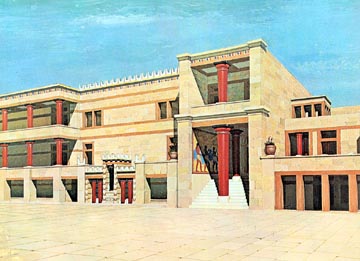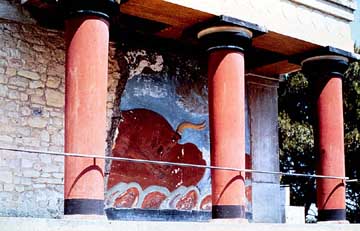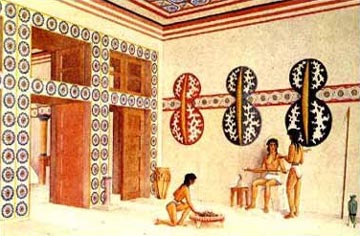
Plan of the Palace at Knossos
The Palace of Knossos sprawls in what at first would appear to be an unorganized arrangement of courtyards, rooms, and corridors.

Aerial View
The Palace of Knossos was built over the remains of an earlier Neolithic settlement on a low hilltop. It was not fortified; the Minoans appears to have relied on their strength at sea to protect the island of Crete against invasion.

Artist's Reconstruction
The central point of focus of the palace complex was a rectangular paved court around which the buildings were grouped. The main rooms of the
palace were grouped around the court. These included the major living quarters, religious areas, reception rooms, storerooms, etc. Minoan palaces reveal a well-organized system for receiving and distributing local agricultural products.

View south on west side of court
Minoan architecture employs a post-and-lintel system; there are no arches or domes.
|

View south on west side of court
View south towards the sacred mountain, Mt. Iuktas.

The west side of the court (an artist's reconstruction)
A series of rooms on the west side of the court are considered to be of cult character. A conspicuous feature of this side of the court is the great staircase that gives access to the rooms on the upper floor. A wooden
column on a round base stands in the middle of the flight of stairs. To the right, or north, a simple partitioned entrance leads down a short flight of steps to the Throne Room.

Interiors
Most rooms have low ceilings, stone masonry walls, and short, wooden columns that taper slightly toward a thin square base. Their puffy capitals are called pillow capitals.

North Gateway
The architecture, and the fresco of the bull, were restored by Arthur Evans

The 'Queen's' Hall
The so-called 'Queen's' Hall, comprising a suite of rooms, is spacious and high-ceilinged. The main room, pictured here, is decorated with a frieze of dolphins. Panels decorated with rosettes (or spirals) surrounds the door openings and run across the walls.

Hall of the Double Axes
Restoration of the East End by Piet de Jong under the supervision of Nikolaos Platon.
|
| | | | | | | |

 SPRING 2016
SPRING 2016  SCHEDULE
SCHEDULE  REQUIREMENTS
REQUIREMENTS

 SPRING 2016
SPRING 2016  SCHEDULE
SCHEDULE  REQUIREMENTS
REQUIREMENTS